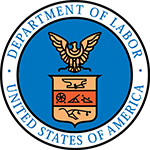
US Department of Labor
Occupational Safety and Health Administration

Occupational Safety and Health Administration (OSHA) Enforcement
The Occupational Safety and Health Administration (OSHA) is authorized by the Occupational Safety Health Act of 1970 (OSH Act) to assure employers provide safe and healthful conditions for working men and women free of recognized hazards and by setting and enforcing standards and providing training, outreach, education, and technical assistance. OSHA also establishes cooperative programs to partner and work collaboratively with employers, employees, and other stakeholders. OSHA balances enforcement and cooperative programs to reduce workplace injuries, illnesses, and fatalities.
OSHA INSPECTION ACTIVITY
In FY 2024, OSHA conducted 34,625 inspections comprising 17,455 unprogrammed and 17,170 programmed inspections. Unprogrammed inspections include those initiated by employee complaints, injuries/fatalities, and referrals. Programmed inspections are those initiated by emphasis programs to OSHA’s enforcement resources on industries and operations where known hazards exist (e.g., heat, respirable silica, combustible dusts, chemical processing, ship-breaking, and falls in construction).
| OSHA Inspection Statistics | FY 2019 | FY 2020* | FY 2021* | FY 2022 | FY 2023 | FY 2024 |
|---|---|---|---|---|---|---|
| Total Inspections | 33,393 | 21,710 | 24,333 | 31,820 | 34,221 | 34,625 |
| Total Programmed Inspections | 14,900 | 8,729 | 10,584 | 14,081 | 15,844 | 17,170 |
| Total Unprogrammed Inspections | 18,493 | 12,981 | 13,749 | 17,739 | 18,377 | 17,455 |
| ~ Fatality/Catastrophe Inspections | 919 | 1,498 | 1,386 | 1,119 | 952 | 863 |
| ~ Complaints Inspection | 7,391 | 4,592 | 4,955 | 6,789 | 8,221 | 7,509 |
| ~ Referrals | 6,718 | 4,810 | 5,310 | 6,091 | 6,419 | 6,340 |
| ~ Other Unprogrammed Inspections | 3,465 | 2,081 | 2,098 | 3,740 | 2,785 | 2,743 |
| *This period represents the height of the COVID-19 pandemic. | ||||||
In FY 2025, the Enforcement Impact Index (EII) replaced the OSHA Weighting System (OWS). The EII applies weighting based on three criteria: the use of significant enforcement resources, targeting specific hazards from emphasis programs, and addressing agency priority goals. These inspections often involve complex enforcement actions, such as addressing health hazards, process safety, and high-risk industries. With EII, the agency can use the impact criteria to evaluate how inspections align with its broader safety, health and enforcement objectives.
| OSHA EII Value Summary | FY2022 | FY2023 | FY2024 | |||
|---|---|---|---|---|---|---|
| Programmed | Unprogrammed | Programmed | Unprogrammed | Programmed | Unprogrammed | |
| Base Value | 26,466 | 40,979 | 30,238 | 42,220 | 33,030 | 40,739 |
| Dynamic Value | 1,344 | 6,202 | 2,619 | 7,068 | 7,743 | 9,322 |
| Investigation Value* | -- | 3,165 | -- | 3,333 | -- | 3,295 |
| Final EII Value | 27,810 | 50,346 | 32,857 | 52,621 | 40,773 | 50,061 |
For additional information on OSHA inspections and services please refer to the OSHA Inspection Fact Sheet for information on OSHA inspections, OSHA's Compliance Assistance Specialists and their services, and OSHA's free on-site assistance for small employers.
For information on employee rights, see the OSHA Worker webpage.
For information on employer responsibilities and other compliance assistance resources see the OSHA Help for Employers webpage.

